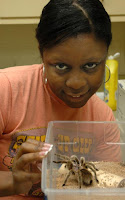Ground Spider Diversity Studied in Research Project.
| COLLEGE STATION – None of Takesha Henderson's discoveries are named Charlotte, but they are weaving a new chapter in Texas entomology. Her graduate studies at Texas A&M University have led to the discovery of 25 new spiders in Brazos County and one species found for the first time in Texas. High Resolution Image |  |
 | In research sponsored by the National Science Foundation, Henderson, who is earning a master's degree, has been studying ground spider diversity, distribution and abundance in the 515-acre Lick Creek Park south of College Station. She has caught 1,000 specimens in 111 species over two years. The most common were several species of wolf spiders, she said. High Resolution Image. |
| Henderson set out pitfall traps – made of plastic cups, funnels and animal-safe antifreeze – to collect the spiders. High Resolution Image. |  |
The collected samples are being identified and placed in the Texas A&M Insect Collection, department of entomology.
Dr. Marvin Harris, Texas Agricultural Experiment Station entomologist and chair of Henderson's master's committee, began working with her when she was an undergraduate.
"Takesha's work at Lick Creek Park is expanding our knowledge of this local natural resource and the role such habitats play in nature," Harris said. "This knowledge can enrich our human experience and can also be used in larger studies of biodiversity and production agriculture involving spiders."
For people who think the only good spider is a dead spider, Henderson has this to say: A diverse spider population signifies a healthy habitat.
Spiders "help maintain the balance of nature," said Dr. John Jackman, Texas Cooperative Extension entomologist in College Station, "They help keep a lid on the population of arthropods. They keep us from being covered up with everything else."
The spider inventory at Lick Creek will give researchers a baseline for further studies on biodiversity and the impact of humans on the environment, Henderson said.
Henderson's studies have allowed her to continue a childhood interest. She remembers being intrigued by insects and tarantulas when she was young. "My parents wondered why I liked eight-legged creatures," Henderson said. "Mom couldn't stand it at first."
But her parents allowed her to keep her collection as long as the tarantulas and spiders didn't get out into the house, she said.
As an undergraduate, Henderson took her parents, who lived in Brenham at the time, to some of her classes.
"Her enthusiasm for spiders was backed by the hard work required for her to become proficient in their identification and to study their biology," Harris said.
In all of her collecting and studies, Henderson has never been bitten, although she has had a skin irritation caused by a rosehair tarantula flicking off some of its abdominal hair, she said.
Henderson hopes her studies will be a stepping stone to a new career when she graduates in May. "There are few arachnologists," she said. "But that (knowledge) comes in handy when someone gets bitten or you have major spider problems."
The City of College Station has a long-term commitment to inventory the park, which has diverse plant and animal populations, for changes in habitat, she said. The park has areas for hiking, bird watching and horseback riding, and is one of the areas that has Navasota Ladies'-Tresses, an endangered orchid. More information on the park can be found (in PDF format) at cstx.gov/docs/lick_creek_brochure .
A free publication that describes common Texas spiders is available from the Extension Bookstore at tcebookstore.org/ . Click on "Insects" and then "Spiders."
Writer: Edith Chenault, 979-845-2886, EChenaul@ag.tamu.edu Contact: Takesha Henderson. 979-845-9757, takesha@tamu.edu Dr. Marvin Harris, 979-845-9757, m-harris@tamu.edu
Technorati Tags: Ground Spider Diversity and Takesha Henderson or Texas entomology and Lick Creek Park and Texas Agricultural Experiment Station or biodiversity and tarantulas and spiders or biology and Texas A&M











No comments:
Post a Comment